eJournal: uffmm.org,
ISSN 2567-6458, 3.May 2019
Email: info@uffmm.org
Author: Gerd Doeben-Henisch
Email: gerd@doeben-henisch.de
CONTEXT
Within the AAI paradigm the following steps will usually be distinguished:
- A given problem and a wanted solution.
- An assumed context and intended executing and assisting actors.
- Assumed non-functional requirements (NFRs).
- An actor story (AS) describing at least one task including all the functional requirements.
- An usability test, often enhanced with passive or interactive simulations.
- An evaluation of the test.
- Some repeated improvements.
With these elements one can analyze and design the behavior surface of an assistive actor which can approach the requirements of the stakeholder.
SIMULATION AND GAMING
Comparing these elements with a (computer) game then one can detect immediately that a game characteristically allows to win or to lose. The possible win-states or lose-states stop a game. Often the winning state includes additionally some measures how ‘strong’ or how ‘big’ someone has won or lost a game.
Thus in a game one has besides the rules of the game R which determine what is allowed to do in a game some set of value lables V which indicate some property, some object, some state as associated with some value v, optionally associated further with some numbers to quantify the value between a maximum and a minimum.
In most board games you will reach an end state where you are the winner or the loser independent of some value. In other games one plays as often as necessary to reach some accumulated value which gives a measure who is better than someone else.
Doing AAI analysis as part of engineering it is usually sufficient to develop an assistive actor with a behavior surface which satisfies all requirements and some basic needs of the executive actors (the classical users).
But this newly developed product (the assistive actor for certain tasks) will be part of a social situation with different human actors. In these social situations there are often more requirements, demands, emotions around than only the original design criteria for the technical product.
For some people the aesthetic properties of a technical product can be important or some other cultural code which associates the technical product with these cultural codes making it precious or not.
Furthermore there can be whole processes within which a product can be used or not, making it precious or not.
COLLECTIVE INTELLIGENCE AND AUTOPOIETIC GAMES
In the case of simulations one has already from the beginning a special context given by the experience and the knowledge of the executive actors. In some cases this knowledge is assumed to be stable or closed. Therefore there is no need to think of the assistive actor as a tool which has not only to support the fulfilling of a defined task but additionally to support the development of the knowledge and experience of the executive actor further. But there are social situations in a city, in an institution, in learning in general where the assumed knowledge and experience is neither complete nor stable. On the contrary in these situations there is a strong need to develop the assumed knowledge further and do this as a joined effort to improve the collective intelligence collectively.
If one sees the models and rules underlying a simulation as a kind of a representation of the assumed collective knowledge then a simulation can help to visualize this knowledge, make it an experience, explore its different consequences. And as far as the executive actors are writing the rules of change by themselves, they understand the simulation and they can change the rules to understand better, what can improve the process and possible goal states. This kind of collective development of models and rules as well as testing can be called autopoietic because the executing actors have two roles:(i) following some rules (which they have defined by themselves) they explore what will happen, when one adheres to these rules; (ii) changing the rules to change the possible outcomes.
This procedure establishes some kind of collective learning within an autopoietic process.
If one enriches this setting with explicit goal states, states of assumed advantages, then one can look at this collective learning as a serious pattern of collective learning by autopoietic games.
For many context like cities, educational institutions, and even companies this kind of collective learning by autopoietic games can be a very productive way to develop the collective intelligence of many people at the same time gaining knowledge by having some exciting fun.

